I realize it’s been a minute since I’ve given an update regarding Willa’s health & wellbeing. I’ll
Category: Dogs
Animal First Aid
I wanted to make a little post regarding some basic animal first aid that I feel folks should know regardless of the types/amount
My Griffon Experience
So it’s taken me a while to muster up the gall and quite frankly to find the time to do a write up about my very
Why I Love Training Dogs
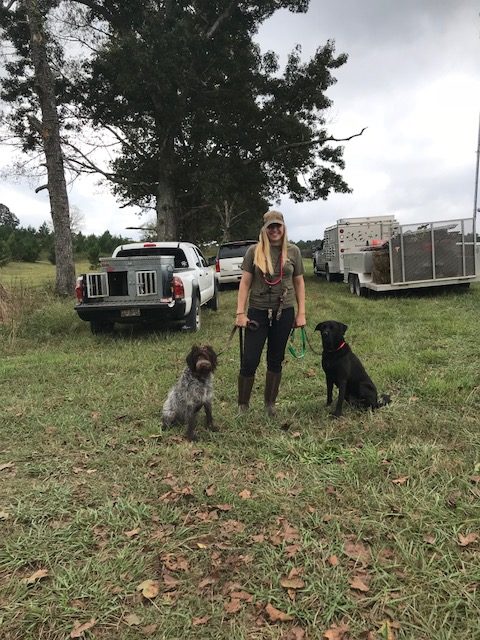
I am writing this post not as a ‘professional’ giving advice, for I am not a pro; I simply enjoy working with and training our own dogs. The first dog I ever trained myself was my mutt, Brantley. He has been a JOY to train, he learns quickly, and is extremely intelligent. He is also opinionated and will tell you when he doesn’t want to do something. Overall, he was an easy dog to train, and as my first, we had a huge learning curve. We were both learning together as I trained him from ground zero. He has turned into a fantastic hunting partner (my favorite) and pet. Don’t get me wrong, Brantley has his quirks (ie. he whines in the duck blind), but when you ask him to do something, he does it. I even had the pleasure of running him in a started HRC hunt test via UKC (I had him performance registered) where he received a ‘pass.’ He’s a great dog, my heart dog, and training him was a complete 180 from training Miss Willa.
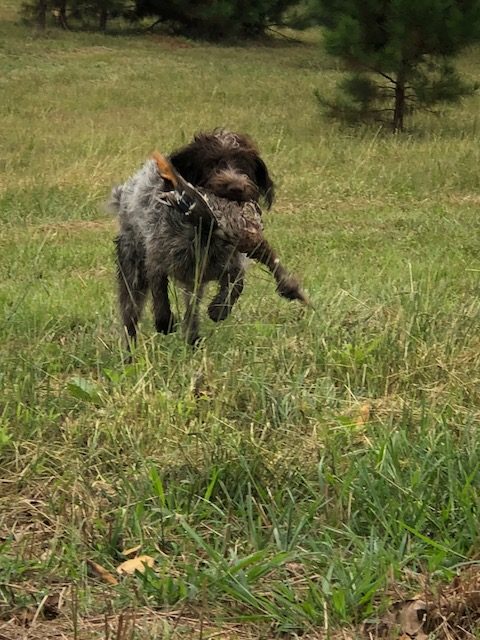
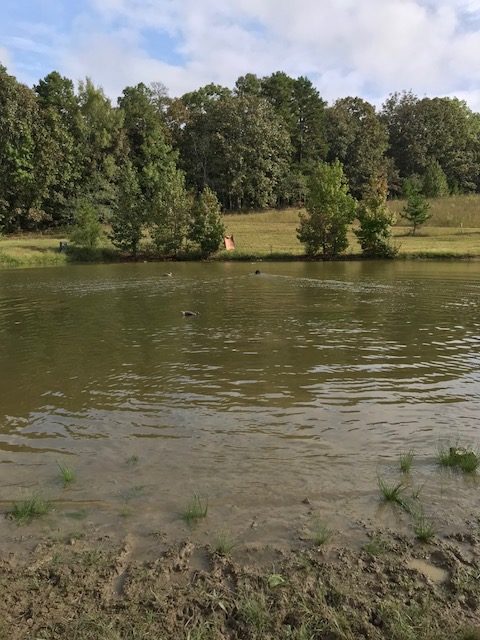
Willa joined our family in February 2018. She is a wirehaired pointing griffon (WPG/griff). She came to us from Chapel View WPG’s (Larry Fiske) in West Bend, WI. While we had some issues getting her registered (I would NEVER recommend this breeder to anyone), her personality has always been great, and without the technical difficulties she is an AWESOME dog.

Training Willa from the start was much different than training Brantley. Brantley was potty trained in 3 days as an 8 week old puppy. Willa took FOREVER to potty train. I’ve heard that females can be more difficult than males, however I think Brantley was also unnaturally quick to catch on. She still occasionally has accidents (almost 11 months old). Initial training of commands was also slower with Willa than Brantley. Brantley had such a drive to please and perform, he was retrieving short marks when he was just weeks old. Willa took her time when she was a puppy. Even with treats, she would lose interest quickly. She was quite goofy and dopey, completely different from Brantley (and our other lab, Timber).
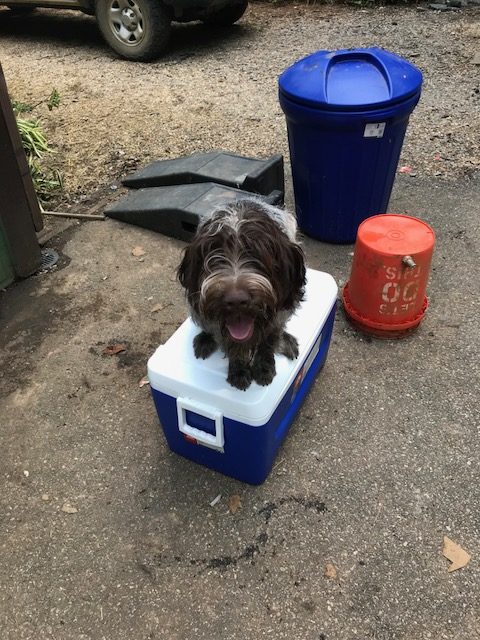
Thankfully, Willa passed out of the puppy stage and found her desire to hunt and work. She LOVES to be out in the field. We took her to retrieve at a pheasant throw in June of 2018 (6 months old) and she both pointed and retrieved her first pheasants. After that, I started her out on some gun dog basics (sit, stay, here, heel, place, whoa, etc.). I used the “Self Training the Hunting Retriever” by Freddy King series on Youtube as a platform for my training program. I had decided even before Willa arrived, that I was going to train her in a more professional and structured manner than how I trained Brantley. She has done very well with it. She force fetched herself. She is taking in new commands and information every single day. We attended some training days over the summer at local NAVHDA chapters, and she ran her Natural Ability (NA) test on 9/8 with a final score of 104 Prize III with high marks except in the tracking portion (my fault for not working her more with it). I was very proud of her. We are currently training to run in the UKC HRC started series. I had hoped to have her SHR (started hunting retriever) title before she turned 1, but she came into heat 10/3 (can’t run bitches in heat in HRC tests) so that won’t happen.

Lately, we have been continuing on the retriever drills, as well as keeping up with basic obedience. I do heeling drills and place commands and she does great with everything. For a while now, though, I have been having some issues teaching whistle sit at a distance. At my side, she’s great. When I try to stop her and get her to sit, she hesitates: she will stand but she refuses to sit down, it’s like I was blowing her mind. I couldn’t figure out the problem, so I gave it some time and we worked on things that she was good at and enjoyed. In doing so, we were working on off leash heeling and it hit me, I realized the problem with the whistle sit. When I had been blowing the whistle to have her sit, I had been doing it almost every time she got to my side. She thought that the command I was using for ‘sit’ meant ‘heel.’ I had taught her that! Silly me, I thought that I was the one teaching this dog, but she is also teaching me. She isn’t as intense as Brantley and Timber are, and she LISTENS instead of interpreting. If you tell her fetch, she’s going to fetch (something), and she thought that I was telling her to heel which is why she became so confused. Once I realized it, I used a new command for sit, and it took her about 3 tries before she realized that command meant sit. One step closer every day for both of us.


Working with animals, dogs especially, keeps me on my toes. I learn something new almost daily. While we absolutely have enough dogs (for a while anyway), I am excited for my next gun dog to work with and train, because I can keep bettering my own methods. I am also looking forward to where the future takes both Willa and Brantley, both dogs have such great potential, I’m hoping they have the opportunity to work together in some upland fields this fall.

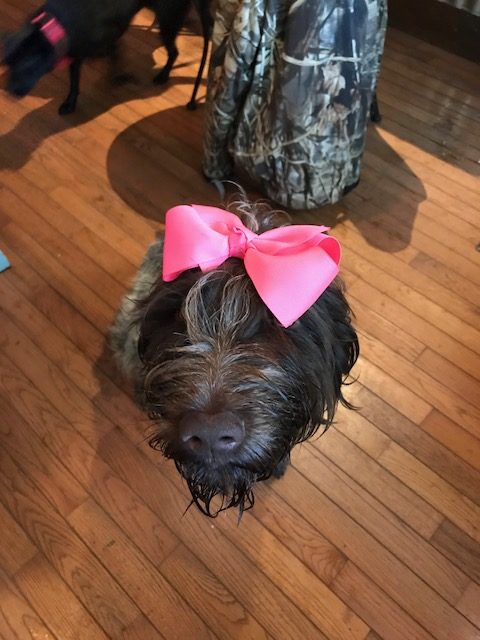
Our Busy Week
I’ve been out of town in Orlando, and I returned 2/12. I leave again 2/19 for Pensacola and hopefully will return promptly. During this time that I have been home, I haven’t accomplished a WHOLE lot, but we did have some exciting things happen.
First off, we had three litters of rabbits born. One purebred Silver Fox (Rain x Powder), with 3 blues & 3 lilacs (YAY!); and two SF x NZ (Charming x Sookie & Charming x Queenie). Unfortunately, Sookie only birthed one GIGANTIC, white kit, which I found dead in the nest on 2/16 AM. Queenie had four, two blues and two broken blues. Faith was bred but didn’t kindle, I’m going to rebreed she and Sookie this weekend. This is Powder’s first successful litter, and she is going GREAT! And of course the old pro Queenie is doing well too, all 10 surviving kits between the 2 litters look lovely. Hoping to keep one from each litter (a lilac for sure), but we will see.
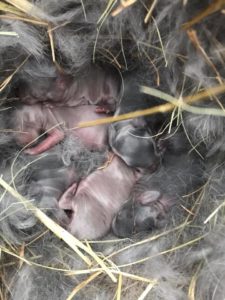
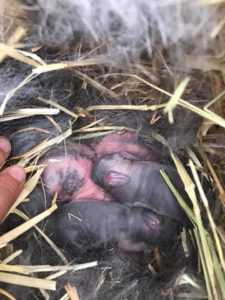
Then, on Thursday (2/15), we added a new family member to the farm. I finally was able to pick up our newest dog, an 11 week old Wirehaired Pointing Griffon female, who we have named Willa. She is going to be our next bird dog, and hopefully will be able to hunt side by side with Brantley and Timber. WPGs are hypoallergenic and do not shed, though they do have a wiry coat that requires grooming. If all goes well, we will have her hunt tested in at least AKC & NAVHDA and if she passes her tests plus health certifications, we plan to breed her down the road.

All 11 chicks are still alive, and all named. The cream legbars are Edith, Mary, & Sybil (Downton Abbey), lavender orpingtons are Mavis, Slick, and Fiona, and OEs/marans are Bertha, Mimzy, Izma, Becky, and Esther. 🙂
“Bone Milk”
First, you need to make broth. I do this for myself by putting a whole chicken in the crock pot and adding water to (almost) cover the bird, then throw in some garlic, carrots, celery, onions, bay leaves, salt, pepper, and whatever else you’re so inclined to add. If you’re making “dog broth,” simply add a chicken to the pot and add water – no other herbs, veggies, or spices necessary.
Allow your chicken to cook on high for 1 hour (this helps warm it up quicker), then finish on low for 7 hours.
Once your broth is finished can (or freeze it), and save it for later. Pick your chicken meat and do with as you please (I freeze it later for soup/tacos/etc.). If you made broth and chicken for your dog (or cat), the same process applies.
Once you have picked your chicken clean so that all that’s left are the bones, give them a good rinse in the sink, then toss them back in the crock pot (don’t wash it so that whatever was stuck to the bottom/sides remain) with enough water to cover, and maybe just a tiny bit of the broth if you’re so inclined. If you made your chicken broth and chicken for human consumption, I forego the addition of the broth since you don’t want any added salt.
Turn your crock pot on high for 1 hour, then reduce to low for another 8-10 hours (more or less). You want to cook the bones until they become powdery and you can squeeze them and they’ll break apart. Once you’ve achieved powdery/brittle bones, toss everything in a blender or food processor (let it cool a bit if you don’t want to burn yourself) and blend a couple of pulses until it becomes a thin, pulpy consistency. That’s it. Super simple. Put the “bone milk” into containers and refrigerate if you plan on feeding it or freeze to feed later. Our dogs AND chickens love it, and you’ve just cooked a whole chicken with ZERO waste!!! This can be done with pretty much any bones – beef, pork, venison, rabbit, etc. Bone milk provides a high calcium, nutrient dense snack for on top of your pup’s (or other animal’s) regular dinner. The benefit of it being cooked in the same pot that the broth was cooked in is that some of that beneficial, gelatinous collagen remains, so that provides another added nutritional benefit as well!
Genetic Diseases
Some species of animals have such a vast and healthy gene pool that genetic diseases do not exist, however animals who are commonly bred as pets or performance animals generally have at least one, if not multiple, potential genetic diseases that they can be affected by.
So, what are genetic diseases?
Simply put, genetic diseases are any disease that is hereditary and can be passed from parent to offspring through genes. Additionally, the ONLY way for a genetic disease to be passed from one animal to another is through breeding and genes. For instance, a common cold, is NOT a genetic disease. Syphilis is also NOT a genetic disease – though it can be passed from parents through offspring (via the act of giving birth), it is not passed on genetically. Equine Hyperkalemic Periodic Paralysis Disease (HYPP) IS a genetic disease, affecting horses. It is ONLY passed on from parents to offspring through genes.
Where did genetic diseases come from?
Genetic diseases can often occur when breeding animals of unknown quality or genetics. An unknown or questionable gene pool can introduce genetic diseases into otherwise very healthy animals. Genetic diseases likely came about many years ago due to breeding a close-knit gene pool in an effort to achieve specific traits (such as specific colors, heavy muscling, or other varying “desirable” factors). Breeding animals within one specific gene pool can display desirable traits, but it will also amplify negative traits as well, including genetic diseases. Genetic diseases can also be caused by gene mutations, and additionally, when breeding in a small gene pool, the likelihood that these mutations will be passed on and couple up with other mutated genes is far more likely than when breeding vastly unrelated stock.
How are diseases displayed and carried?
Many genetic diseases in animals are displayed in 3 forms (we will use the letters D/N to display the theoretical diseases we are talking about):
– NN: homozygous recessive or an animal that is NOT affected
– D/N: heterozygous carrier or an animal that is not affected but carries one copy of the gene that can cause the disease
– DD: homozygous dominant or an animal that IS affected by the disease
For example, in dogs, Centronuclear Myopathy (CNM) would be displayed as NN for a dog that does not carry the disease, D/N for a dog carrying one copy of the gene, and DD for a dog carrying two copies which is affected by the disease.
Some genetic diseases, however, are homozygous OR heterozygous affected diseases (dominant disorders), HYPP in equines is one example. These diseases are as seen below:
– NN: animal is not affected nor a carrier
– D/N: animal is a carrier of one copy of the gene, and IS affected by the disease
– DD: animal is a carrier of both copies of the gene and is also affected by the disease
In this case, in order to have a disease-free animal with ZERO chance of passing the disease to its offspring, only NN animals should be bred.
What animals
The Latest News & Goings On
All of Sookie’s kits are doing very well! All 8 are still alive, turned one week old today and getting immensely cuter. There is one BEHEMOTH of a blue kit that has far surpassed the others in size, likely would be my pick of the litter if I do decide to keep any.


I made one of my best loafs of bread ever last week for a friend’s birthday – cinnamon honey loaf. It smelled and tasted fantastic. I gifted it with some homemade persimmon jelly. 🙂

I had forgotten to write about Timber’s first hunt test – on 9/10 she completed her first started hunter pass for UKC/HRC. Three more passes and she will have completed her started hunter title. We have plans to run her in Alabama in October and then either GA or SC in November, hopefully for her title. We are very proud of her and how far she has come!

One other note, we got our first duck egg yesterday! I am super excited. I have not used it yet, but am planning on just frying it up and eating it with toast for dinner tonight. I love our duckies!

Labor Day Weekend!

Last week I dehydrated a LOT of various peppers, tomatoes, herbs, etc. in order to have some things to start making into Christmas presents! I also started a small batch of fermented garlic in honey to use for cooking and as cold and flu preventive – since it’s getting to be that season again! I’ve been making so many sun dried tomatoes it’s unreal, and they taste SO GOOD. My garden has been providing so much for me this year.

So on Thursday, Justus surprised me by letting me know that he was getting some various miscellaneous chicken related items from a friend who was moving and getting out of chickens. For $20, we received 4 waterers, a feeder, a large aluminum storage can, a large brooder box, and a heat lamp. We ALSO were gifted his coop and run! I have never been more excited. In the spirit of filling our new enclosures…Justus then decided we should go to the local livestock auction in Summerville on Friday night. I should be credited for ONLY purchasing a pair of ducks and one rabbit – I was itching for a goat. We came home with my gorgeous new pair of Welsh Harlequins (see my post regarding egg laying ducks; they’re also listed on the Watch list of The Livestock Conservancy [see post]) – Emmy and Uppy (so named by my niece).


Saturday was dove season opener, so of course we partook. Got the dogs out and hunted from noon until about 7pm. Brought home 12 on Saturday then 24 on Monday when we hunted again (though most of those were gifted). The dogs got worked every day this weekend (Sunday we used some mallards and did some hunt test prep since Timber’s first test is next weekend).




Sunday morning we realized that our quail hen finally hatched her chicks! We have nine very tiny baby quail. When I checked on Saturday, no chicks, but both the hen and her boyfriend attacked me. It’s quite interesting that all 3 adult birds – the hen and two cocks – all share in caring for the chicks. The males will sit on the babies and the chicks also follow the males around. All adults are very protective.

Overall, it’s been a great weekend! 🙂 Couldn’t be happier!
Raw Feeding

Let me start this post off by saying that our dogs are NOT exclusively raw fed, and this post is more about my own experience and opinions on a raw diet. I just don’t have the time or money to strictly raw feed them right now. It’s in the plans for the future once I am producing enough livestock to sustain them, but for now, its just an additive to their diet, which they love.
There is a large amount of controversy over raw feeding. Many people will not recommend it due to possibilities of salmonella, not just in your dogs, but also the possibility of yourself or other humans whom your dogs come in contact with contracting the illness. I have never been worried about this, I have a strong immune system and my dogs don’t make contact with people without my presence or knowledge.
We choose to supplement our dogs kibble diet with raw meat, eggs, and veggies. It helps cut down on the cost of kibble (right now we are paying $40/28lb bag for natural, grain-free dog food) and the dogs love it. I have noticed that since we have started feeding them a partially raw diet, their teeth look fantastic (from munching bone, skin, and cartilage), their skin and coats are gleaming, they have a ton of energy, and they are quite happy little creatures.
There are multiple methods of raw feeding including whole prey (feeding entire animals – ie. hair/feathers, feet, heads, innards, etc.), dressed out, and supplemental.
The way I do it, our dogs have kibble for breakfast, always. They are fed 12 hours apart to even out hunger & nutrient absorption (at least in my mind anyway). For dinner, some nights they have kibble with additives such as veggies, egg, coconut milk, or yogurt, and other nights they have no kibble and only consume meat in the form of either organs, dressed out carcasses, or muscle. Some of their favorite things include:
– coconut milk & coconut oil (helps bad breath, shiny coat, digestion)
– plain whole milk yogurt (probiotics)
– raw eggs from my chickens (good for their skin & coat)
– sweet potatoes (good for their teeth & gums)
– asparagus (fiber, vitamins A,K)
– green beans (fiber)
– liver (vitamins & minerals)
– rabbit & chicken feet
– whole rabbit, duck, & quail
– fish such as salmon, trout, or catfish (wild caught)
I try to vary the types of meat that I feed them, a full raw diet is about 80% meat, 10% bone, 5% organs & 5% liver at a general amount of 2.5% of their total body weight (ie. if I was raw feeding Brantley entirely, he weighs 70 lbs, so he would need a total daily intake of 1.75lbs in the following increments: 1.4 lbs meat, 0.175 lb bone, 0.09 lb organs & 0.09 lb liver). Considering that a dressed out rabbit usually weighs between 1.5-3.5+/- lbs, his daily intake is pretty small.
Whenever we go to the vet, I always receive complements regarding how great my dogs look. Their weight is always on par, they have little to no tartar buildup, they have healthy, shiny coats, and they are also well behaved with a great demeanor. I attribute this to my feeding system, and I would never go back to feeding solely kibble. I can’t wait to move forward in the future with a full raw feeding system, and I encourage you to look into the diet if you have questions regarding your pets!
